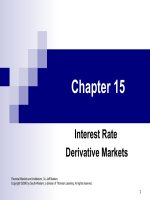Tài liệu Thị trường tài chính và các định chế tài chính_ Chapter 19 pptx
Bạn đang xem bản rút gọn của tài liệu. Xem và tải ngay bản đầy đủ của tài liệu tại đây (163.21 KB, 49 trang )
1
Chapter 19
Bank Management
Financial Markets and Institutions, 7e, Jeff Madura
Copyright ©2006 by South-Western, a division of Thomson Learning. All rights reserved.
2
Chapter Outline
Bank management
Managing liquidity
Managing interest rate risk
Managing credit risk
Managing market risk
Operating risk
Managing risk of international operations
Bank capital management
Management based on forecasts
Bank restructuring to manage risks
Integrated bank management
3
Bank Management
The goal behind managerial policies of a bank is
to maximize the wealth of the bank’s
shareholders
Managers may be tempted to make decisions
that are in their own best interests
Banks can incur agency costs
Banks could provide stock as compensation to managers to
maximize the bank’s stock price
Banks with a low stock price may become takeover targets
4
Bank Management (cont’d)
Board of directors
The board of directors oversees operations of the
banks and attempts to ensure that managerial
decisions are in the best interests of shareholders
Bank boards tend to contain a higher percentage of
outside members than boards of other types of firms
Functions of bank directors are to:
Determine a compensation system for bank executives
Ensure proper disclosure of the financial condition and
performance
Oversee growth strategies such as acquisitions
Oversee policies for changing capital structure
Assess performance and ensure that corrective action is
taken if there is weak performance
5
Managing Liquidity
Banks can experience illiquidity when cash outflows
exceed cash inflows
Illiquidity can be resolved by creating additional liabilities or
selling assets
Banks should maintain the level of liquid assets that will
satisfy their liquidity needs but use their remaining funds
to satisfy their other objectives
Research has shown that high-performance banks are able to
maintain relatively low liquidity
Use of securitization to boost liquidity
Securitization commonly involves the sale of assets by the bank
to a trustee who issues securities that are collateralized by the
assets
Securitization converts future cash flows into immediate cash
6
Managing Interest Rate Risk
Bank performance is influenced by the interest payments
earned relative to the interest paid:
During a period of rising interest rates, a bank’s net interest
margin will likely decrease if its liabilities are more rate sensitive
than its assets (see next slide)
During a period of decreasing interest rates, a bank’s net
interest margin will likely increase if its liabilities are more rate
sensitive than its assets (see next slide)
Assets
expenses Interest - revenues Interest
margin interest Net =
7
Managing Interest Rate Risk
(cont’d)
%
%
Time
Time
Rate on Loans
Cost of FundsSpread
Increasing Interest Rates Decreasing Interest Rates
Cost of Funds
Rate on Loans
8
Managing Interest Rate Risk
(cont’d)
To measure interest rate risk, a bank measures
the risk and then uses its assessment of future
interest rates to decide whether and how to
hedge the risk
Methods used to assess interest rate risk:
Gap analysis
Duration analysis
Regression analysis
9
Managing Interest Rate Risk
(cont’d)
Methods used to assess interest rate risk
(cont’d)
Gap analysis
Gap is defined as:
The gap ratio is the volume of rate-sensitive assets divided
by rate-sensitive liabilities
sliabilitie sensitive Rate - assets sensitive RateGap
=
10
Computing A Bank’s Gap and
Gap Ratio
Philly Bank generated interest revenues of $100 million last year and
$45 million in interest expenses. Philly bank has $2 billion in
assets, of which $800 million are rate-sensitive. Philly also has
$700 million in rate-sensitive liabilities. What are Philly Bank’s gap
and gap ratio?
%29.114
000,000,700$
00$800,000,0
ratio Gap
000,000,100$
000,000,700$000,000,800$
sliabilitie sensitive Rate - assets sensitive RateGap
==
=
−=
=
11
Managing Interest Rate Risk
(cont’d)
Methods used to assess interest rate risk
(cont’d)
Gap analysis (cont’d)
Banks often classify assets and liabilities into categories
based on the time of repricing and calculate a gap for each
category
Banks must decide how to classify their liabilities and assets
as rate sensitive versus rate insensitive
Each bank may have its own classification system, because
there is no perfect measurement of gap
12
Managing Interest Rate Risk
(cont’d)
Methods used to assess interest rate risk
(cont’d)
Duration measurement
Duration can capture the different degrees of interest rate
sensitivity:
The duration of a bank’s asset portfolio is the weighted
average of the durations of the individual assets
∑
∑
=
=
+
+
=
n
t
t
t
n
t
t
t
k
C
k
tC
1
1
)1(
)1(
)(
DUR
13
Managing Interest Rate Risk
(cont’d)
Methods used to assess interest rate risk (cont’d)
Duration measurement (cont’d)
The bank can also estimate the duration of its liability portfolio and
then estimate the duration gap:
A duration gap of zero means the bank is not exposed to interest
rate risk
Banks with positive duration gaps are adversely affected by rising
interest rates and positively affected by declining interest rates
( )
[ ]
LIAB/ASDURLIAB-DURASDURGAP ×=
14
Managing Interest Rate Risk
(cont’d)
Methods used to assess interest rate risk
(cont’d)
Duration measurement (cont’d)
Assets with shorter maturities have shorter durations
Assets that generate more frequent coupon payments have
shorter durations
The capabilities of duration are limited when applied to
assets that can be terminated on a moment’s notice
15
Managing Interest Rate Risk
(cont’d)
Methods used to assess interest rate risk
(cont’d)
Regression analysis
A bank can assess interest rate risk by determining how
performance has historically been influenced by interest
rate movements
A proxy must be chosen for bank performance and for
prevailing interest rates and regression analysis can be
applied:
uiBRBBR
m
+++=
210
16
Managing Interest Rate Risk
(cont’d)
Methods used to assess interest rate risk (cont’d)
Regression analysis (cont’d)
A positive (negative) coefficient suggests that performance is
favorably (adversely) affected by rising interest rates
If the interest rate coefficient is zero, the bank’s stock returns are
insulated from interest rate movements
The vast majority of research has found that bank stock levels are
inversely related to interest rate movements
Regression analysis can be combined with the value-at-risk
(VAR) method to determine how its market value would change in
response to specific interest rate movements
17
Managing Interest Rate Risk
(cont’d)
Determining whether to hedge interest rate risk
Banks should consider using their measurement of
interest rate risk along with their forecast of interest
rate movements to determine whether they should
hedge
Since none of the measures is perfect for all
situations, some banks measure interest rate risk
using all three methods
In general, the three methods should lead to a similar
conclusion (see next slide)
18
Gap Analysis
If the bank’s gap is:
Negative
Positive
Increase
Increase
Decrease
Decrease
…and interest rates
are expected to:
…the bank should:
Consider hedging
Remain unhedged
Remain unhedged
Consider hedging
19
Duration Gap Analysis
If the bank’s
duration gap is:
Negative
Positive
Increase
Increase
Decrease
Decrease
…and interest rates
are expected to:
…the bank should:
Remain unhedged
Consider hedging
Consider hedging
Remain unhedged









